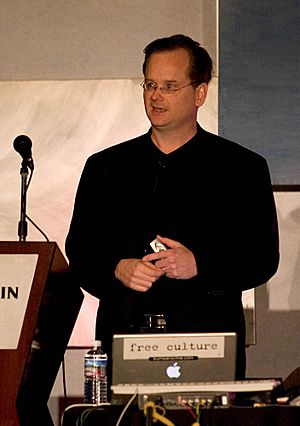Free-culture movement facts for kids

The free-culture movement is a group of people who believe that creative works should be easy for everyone to share, use, and change. This includes things like music, art, books, and videos. They think that too many rules, especially about copyright, stop people from being creative and sharing ideas.
Many people in this movement believe that current copyright laws are too strict. They say these laws make it hard to share and build upon other people's work. They call this a "permission culture" because you often need to ask for permission for everything.
The free-culture movement wants to make it easier to share ideas. It works closely with other groups like the free and open-source software movement. It also connects with ideas like open access (making research free to read) and the remix culture (where people combine existing works to create new ones).
Contents
How the Free Culture Movement Started
Early Ideas
Back in the 1960s, a person named Stewart Brand started something called the Whole Earth Catalog. He believed that technology could help people be more free, not less. In 1984, he famously said, "Information wants to be free." This idea was against governments or companies trying to control who could see or use information.
Why the Movement Began
In 1998, the United States passed a law called the Sonny Bono Copyright Term Extension Act. This law made copyright last for 20 more years, so it would protect works for 70 years after the creator died. Big companies like Disney pushed for this law. Some people even called it the "Mickey Mouse Protection Act."
Lawrence Lessig, a lawyer, thought this law was a problem. He believed that strict copyright rules stopped people from creating new things and sharing knowledge. He traveled around, giving many speeches. His ideas helped start the free-culture movement. This led to the first student group, Students for Free Culture, at Swarthmore College.
In 1999, Lessig challenged the new copyright law in the US Supreme Court. He believed the Constitution meant copyright terms should be "limited." But he did not win the case.
Creating Creative Commons
In 2001, Lawrence Lessig started Creative Commons. This was a new way for creators to share their work. Instead of "all rights reserved" (meaning no one can use it without permission), Creative Commons offers "some rights reserved" licenses. These licenses let creators choose how others can use their work, like sharing it or changing it.
The term "free culture" became popular around 2003. It was used to describe a new type of license for art, similar to how free software works. Lawrence Lessig then wrote a book called Free Culture in 2004, which helped spread the idea even more.
In 2003, a project called the Open Content Project joined Creative Commons. Its founder, David A. Wiley, became a director at Creative Commons.
What "Free Cultural Works" Means
Around 2005, some people in the free-culture movement felt that Creative Commons needed clearer rules for what "free" really meant. So, they worked together to create the "Definition of Free Cultural Works." This definition helped explain what makes a creative work truly "free" to use and share.
In 2008, some Creative Commons licenses were officially approved as "free cultural works." These include the CC BY and CC BY-SA licenses. Licenses that stop people from using works for money or changing them were not approved.
In 2014, the Open Knowledge Foundation said that their definition of "open" for content and knowledge was the same as the "free" definition. They also recommend the same Creative Commons licenses: CC BY, CC BY-SA, and CC0. They also created special licenses for data and databases.
Groups in the Movement

The most well-known group connected to free culture is Creative Commons (CC). It was started by Lawrence Lessig. Creative Commons helps people share their creative works and ideas. This helps culture grow, science improve, and businesses innovate.
Another group is QuestionCopyright.org. Their goal is to show how strict rules about sharing can harm artists and audiences. They also show how sharing freely can be better. This group is known for its work with artist Nina Paley. Her movie Sita Sings The Blues was a big success because it was shared freely.
The student group Students for Free Culture is also part of the movement. The first chapter started in 1998. By 2008, there were 26 chapters.
The free-culture movement takes ideas from the free and open-source software movement. It applies them to all kinds of cultural and creative works, not just computer programs. Richard Stallman, who started the free software movement, supported Creative Commons at first. He later changed his mind about some licenses but then supported them again when those licenses were removed.
The free music movement is part of the free-culture movement. It started in the early 1990s as the internet became popular. It was based on the idea of free software. This movement believed that music could be copied and shared easily and perfectly online. Even though the music industry tried to stop it, free music became very common in the early 2000s. Groups like the Electronic Frontier Foundation and Creative Commons created many licenses for sharing music. The main question became how artists could still make money when their music was so easy to share.
See also
 In Spanish: Movimiento por la cultura libre para niños
In Spanish: Movimiento por la cultura libre para niños
- Access to knowledge movement
- Copyleft
- Copyright abolition
- Criticism of copyright
- Free content
- Free education
- Freedom of information
- Free software
- Information wants to be free
- Internet freedom
- Open content
- Open-design movement
- Open educational resources
- Open-source model
- Open-source movement
- Remix culture
- Sharing economy


